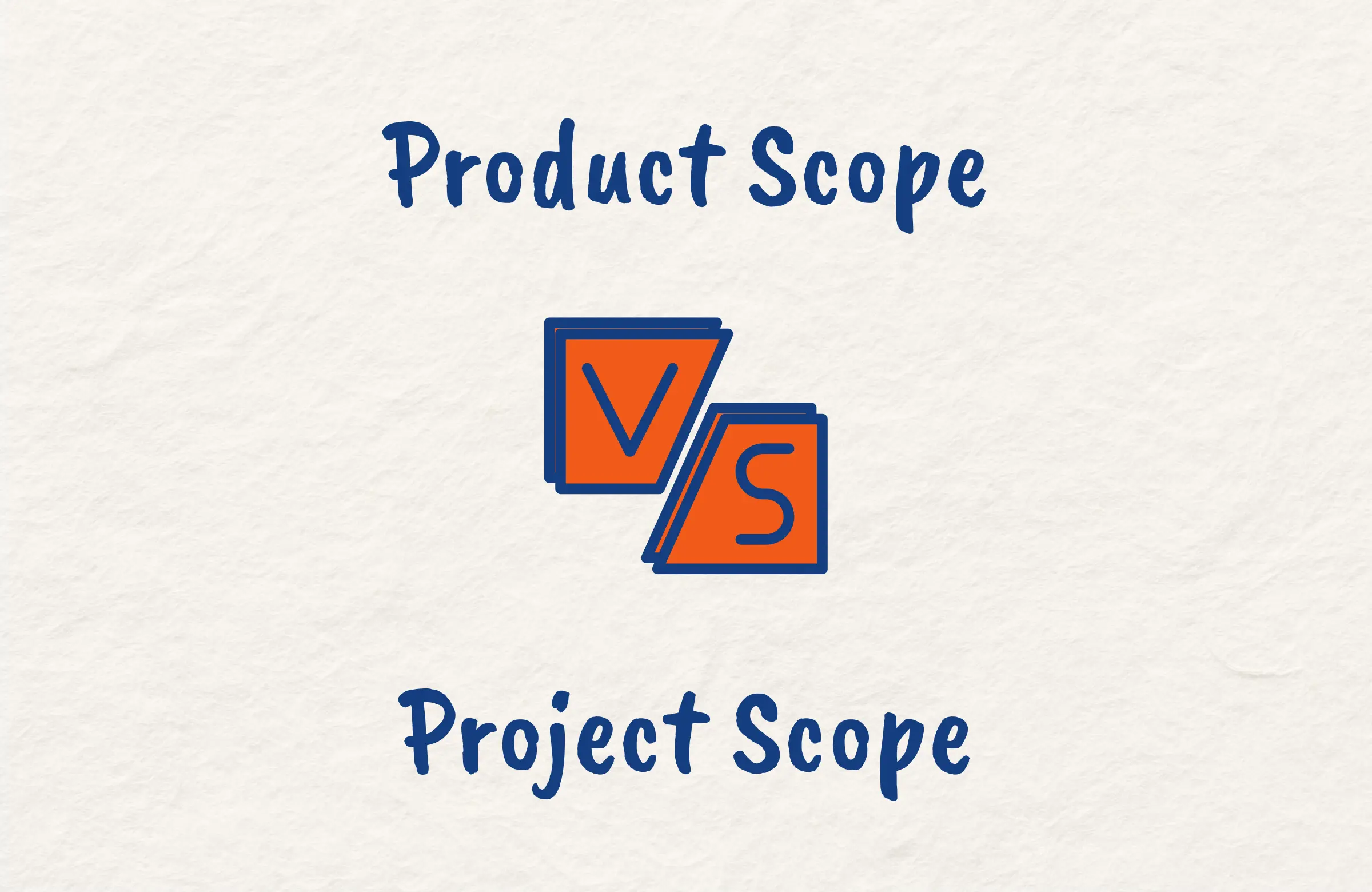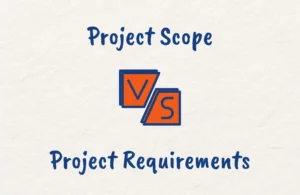Product scope and project scope are two concepts in project management that are often used interchangeably. Though they sound similar, they refer to very different aspects of a project and it’s crucial to understand the difference between them.
In this article, we’ll compare product scope vs project scope to explain what they are, how to determine each, the key differences between the two scopes, and an example to illustrate how they function together in a real-world project.
Whether you’re new to projects or a seasoned project manager, this article provides insights on these important scope concepts. Also, if you are a PMP candidate, we’ll provide tips on answering exam questions on this topic.
Product Scope vs Project Scope: Key Difference
Bottomline Upfront: The main difference between both of them is that the product scope defines the features and requirements of the final deliverable while the project scope outlines the tasks, processes, resources, and work necessary to create the deliverable that meets the defined product scope.
Simply put, product scope focuses on the “what” is to be created and project scope on the “how” to create it.
What is Product Scope?
Product scope defines the characteristics and features of the product, service, or result that the project will be undertaken to create. It refers to the final deliverable that meets the requirements and satisfies what the customer expects from the project.
The product scope serves as the project’s foundation and outlines the end goal that the entire project aims to achieve by delineating the product’s form, function, appearance, and other inherent attributes.
Determining the product scope is crucial because all subsequent project activities hinge on having a clear vision of the final deliverable. The project manager utilizes the defined product scope to develop the project scope and plans.
Product scope locks down requirements so they remain unchanged during project execution, which is key to preventing scope creep.
How to Determine the Product Scope
Defining the product scope is a crucial process that outlines the project’s end goal and this is done early in the project life cycle. Here’s how it typically gets determined:
Identify Stakeholder Needs
The project manager meets with key stakeholders like the project sponsor, customer, and subject matter experts. Through interviews and workshops, they identify the problem to solve, business needs, and requirements for the final deliverable.
Document Requirements
The project manager analyzes all collected requirements and documents them in detail. This includes writing requirement statements, user stories, and scope statements that comprehensively describe the product and its capabilities.
Validate Requirements
The documented requirements get presented back to stakeholders for review and sign-off. The project manager ensures alignment between requirements and stakeholders’ needs through this validation process.
Finalize Product Scope
After resolving any issues from the validation stage, the project manager submits the finalized product scope documentation to project sponsors for approval. Once approved, this becomes the official definition of the product that will guide all project activities.
What is Project Scope?
The project scope outlines the work and activities required to deliver the product, service, or result that meets the defined product scope.
It identifies what needs to be accomplished to achieve the end goal of the project, and encompasses all the tasks, steps, processes, tools, and resources necessary to create the deliverable according to the established requirements.
The project manager utilizes the product scope as the foundation to determine the project scope. While the product scope focuses on the final product, the project scope focuses on the journey and specifies how to get there. It provides direction on how the project will be executed.
The project scope serves as the basis for planning the schedule, budget, resources, procurement, and other project management components needed for successful delivery. It is instrumental in guiding the project so the desired product takes shape as planned.
How to Determine the Project Scope
The defined product scope is leveraged as the foundation to shape the project scope. Here’s how it’s determined:
Analyze Product Scope and Requirements
The project manager thoroughly reviews the product scope documentation, including requirements, to gain a clear picture of the deliverables and objectives. This understanding is imperative to planning the work.
Define Scope of Work
The project manager outlines all of the essential tasks and activities needed to achieve the product scope based on the analysis. The scope of work provides specifics on budget, timeline, resources, processes, and responsibilities.
Develop Project Scope Statement
A detailed project scope statement is created to define the boundaries of the project and the expectations of the work involved. It includes descriptions of deliverables, assumptions, constraints, objectives, and acceptance criteria.
Validate and Approve Project Scope
The defined project scope is reviewed by key stakeholders for validation. Once formally approved, the project scope statement serves as the guiding document for executing the work to meet stated requirements.
Product Scope vs Project Scope Comparison
Now let’s do a head-to-head comparison of the product and project scope to understand their key distinctions:
Focus
The product scope details what the end product should look like and how it should function to meet requirements. It concentrates on defining the characteristics, features, and capabilities required in the final deliverable. It
Project scope focuses on identifying all the specific work, tasks, processes, timelines, resources, and budget necessary to create the product as defined by the product scope. It outlines how to execute the work to completion.
Orientation
The product scope is oriented toward the “what” and describes the tangible specifications and intangible attributes desired from the end product.
In contrast, the project scope is oriented toward the “how” and specifies the means and actions needed to achieve the product scope.
Flexibility
The product scope is meant to remain rather fixed once finalized since changes can significantly impact the end product.
On the other hand, the project scope has more flexibility to be adjusted through change control processes as needed without altering the product scope.
Ownership
The product scope is primarily defined by key stakeholders outside the project team, such as the customer, sponsor, and subject matter experts, and they decide the product details.
The project manager is responsible for analyzing the product scope and determining the comprehensive project scope. They decide how the work will be performed.
Timing
The product scope gets established at the start of the initiation phase before detailed planning begins.
The project scope, in contrast, gets defined afterward in the planning phase once the product scope is finalized and approved and flows directly from the product scope.
Change Impact
Changes to defined product scope often carry greater risk, require rework, and can significantly impact cost and schedule.
Project scope changes tend to be lower risk and have a less dramatic impact overall since project activities can be adjusted more fluidly.
Product Scope vs Project Scope Examples
To further illustrate how these two scopes differ but work together in scope management, let’s look at an example project to build a new mobile app.
The product scope would define the actual app itself. It would contain details like:
- The app will be cross-platform for iOS and Android
- The interface will be simple and user-friendly
- It will enable social photo-sharing capabilities
- Users can apply filters and effects to photos
- It will utilize a distributed cloud storage system
This product scope focuses on the specifications and capabilities of the mobile app product.
While the project scope would then outline how the app gets built:
- Assemble a team of mobile developers and UX designers
- Use Agile methodology for development
- Iteratively develop features over 8 sprints
- Integrate with Cloud Storage API
- Conduct user acceptance testing
- Manage app deployment and release
The project scope centers on the tasks, timeline, resources, and procedures to follow in order to deliver the required mobile app product as outlined in the product scope.
Product Scope vs Project Scope PMP Exam Tips
For PMP candidates, having a good understanding of the difference between product scope and project scope is key for exam preparation.
For your exam:
- Know that product scope is defined in the Collect Requirements process while project scope is defined in the Define Scope process in Project Scope Management.
- Recognize that product scope focuses on the deliverable itself and project scope focuses on the work to create it.
- For situational questions, look for clues if they describe the product being created vs the project execution.
- Be alert for which activities correspond to determining product vs project scope. Requirements elicitation, analysis, and documentation are for product scope. Scope planning, WBS, and scope statements are for project scope.
- Remember that changes to product scope usually have greater impacts to the Triple Constraint than changes to just project scope.
Get comfortable distinguishing between these two foundational scope concepts as it will help you correctly answer exam questions on this topic.
Conclusion
Having a solid grasp of the distinctions between product scope and project scope is vital for successfully managing projects and meeting objectives. Keeping their different focuses and orientations in mind will help you avoid potential confusion.
Always remember that the product scope serves as the foundation for defining the necessary project scope activities. With clarity on how these two key scopes function together, project managers can confidently lead their teams through flawless project execution to deliver the desired product or service.
FAQs
What is the Relationship Between Scope, Project Scope, and Product Scope?
Scope refers to the goals, requirements, and boundaries of a project. The project scope details the work and activities to execute the project. While the product scope defines the characteristics and specifications of the product, service, or result being created by the project.
The project scope stems from and must align to the product scope.
What is the Difference Between Project Scope and Solution Scope?
Project scope outlines the specific work and deliverables to complete the project while solution scope refers to the capabilities and functionality that will be included in the solution or product that the project implements.
Project scope details how to build the solution and solution scope details what the end solution itself will encompass.





